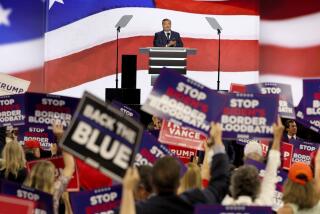Image of Criminals Is Distorted on TV
- Share via
Howard Rosenberg is worried that the top-heavy emphasis on Latino and African American suspects in the new “LAPD” series will reinforce stereotypes that minorities commit most of the crime’LAPD’ Gives Some Polish to Those Badges,” Calendar, Sept. 4). Certainly, TV cop shows like “LAPD” don’t make crime, criminals, dangerous streets or Mark Fuhrmans. But I’m worried that the distorted TV image they create of who commits crime is not just stereotypical, it’s plain wrong.
The FBI Uniform Crime Report, the University of Michigan’s Annual Report on Drug Use, and features in Police Chief, USA Today and Money magazine paint a totally different picture than TV of crime in America. In 1992:
* White males committed 54% of violent crimes in America.
* White males were 70% of the juveniles arrested nationally for criminal offenses.
* White males were 80% of America’s drug users and abusers.
* White males committed 60% of the urban hate crimes.
Former Reagan Administration drug czar William Bennett, in a candid but much-ignored comment, said: “The typical cocaine user is white, male, a high school graduate, employed full time and living in a small metropolitan suburb.” In short, the exact opposite of the type of person that viewers see being hauled away in TV cop shows.
The crime stereotype is not just a TV problem; it takes its toll on real people. I, for example, as a black male, have been followed by security clerks and guards in stores. Women have clutched their purses when I approached. Cabdrivers have refused to pick me up. I’ve been stopped and questioned by police even though I drove a late-model car.
Racial stereotyping also reached an absurd height for Christopher Darden, L.A. County deputy district attorney, who told an L.A. Times interviewer in June that there were occasions when a judge has mistaken him for a defendant during a court appearance.
TV virtual reality crime shows like “LAPD” may give many white TV viewers nightmares about being attacked by blacks and Latinos, but their waking reality is that if they are attacked, their assailant will be white. In 1990, according to a feature in Money magazine, 70% of violent crimes against whites were committed by other whites. Even if blacks did commit most of the violent crime in America-- and they don’t --most whites still wouldn’t be at risk. The 1994 FBI Uniform Crime Report noted that 94% of the victims of black crime and violence are other blacks.
The false and distorted TV picture of crime in America is no accident. The TV networks have spent the past 20 years honing tabloid-style reporting techniques. During the 1970s, the people who ran the ABC affiliates in Philadelphia and New York decided to rev up the ratings. They created Action News.
The concept was simple: find crime, crime and more crime. News teams roamed city streets looking for police car chases, crashes, gang shootouts and drug busts. Most importantly, the city streets they scoured were in black and Latino neighborhoods. It was bloody. It was exploitative. It was racist. It was a smash success. The public loved it. Network profits jumped and their ratings soared. Action News, which began as a lead-in to the regular newscast, soon became the news . Local affiliates in every city copied it.
*
By 1990, an L.A. Times article revealed, 68% of Americans were hooked on Action News nightly broadcasts. The networks spun off legions of hybrid clones. These shows simulated live-action crime chases and busts. “Top Cops,” “Cops” and “America’s Most Wanted” often depicted whites as heroes and minorities as villains. This convinced even more Americans that their lives were at grave risk from violence-prone, drugged-out African Americans and Latinos.
Unfortunately, TV cop show distortions contribute to the steep price society pays on crime. According to the Sentencing Project, a Washington D.C.-based citizen watchdog group, one out of three young black males and one out of seven young Latino males are currently in prison, on parole or on probation. The larger society is not waiting to embrace them when they are released, so they pad the ranks of the growing underclass. Some turn to gangs, guns and drugs as their only alternative.
This doesn’t do much to strengthen family values in the ghettos and barrios. But it does make even more Americans demand less spending on social programs to aid minorities and the poor and more to lock them up. America’s prison population has nearly doubled from 900,000 in 1987 to 1.4 million in 1994. The prison-industrial complex has now replaced the nearly defunct military-industrial complex as America’s largest growth industry.
In California, taxpayers will pay $21 billion over the next 30 years to build 25 new prisons. The annual prison budget has rocketed from $730 million a decade ago to $3 billion today. If the present lock-them-all-up mania continues, there will be no end to the cost escalation.
So while “LAPD” may polish some tarnish from the LAPD badge, the danger is that it may put more tarnish on society.
More to Read
The complete guide to home viewing
Get Screen Gab for everything about the TV shows and streaming movies everyone’s talking about.
You may occasionally receive promotional content from the Los Angeles Times.






